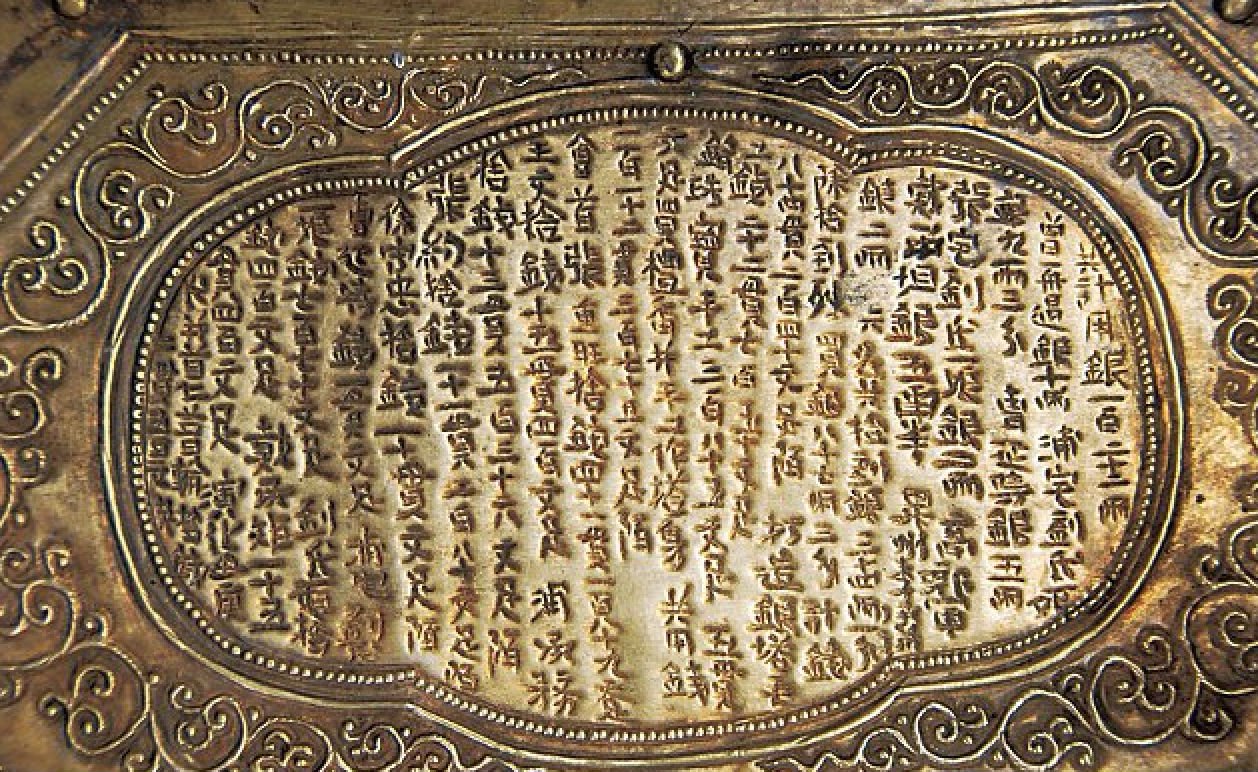Archaeologists have uncovered what they think could be a skull bone of Buddha inside a 1,000-year-old model Buddhist shrine, located in an underground crypt in Nanjing, China.
Inside the crypt, which lies beneath the ruins of an ancient Buddhist temple, researchers found the ornate, 1.2-metre-tall (4-foot) model shrine made of sandalwood, silver, and gold, and decorated with crystal, glass, agate, and lapis lazuli beads. Inside was a tiny gold casket containing a fragment of skull bone.
Just to give you an idea of how special this single bone fragment is, whomever buried it encased it in a tiny golden casket adorned with images of lotus patterns, phoenix birds, and sword-wielding gods.
The golden casket was found inside a larger silver casket, decorated with apsaras - female cloud and water spirits - playing musical instruments. Both caskets were placed inside the model shrine, or stupa, which is a hemispherical structure containing relics or remains of Buddhist monks or nuns, used as a place of meditation.
The shine was hidden inside an iron box, which was enclosed in a large stone casket in the crypt below a once-renowned Grand Bao'en Temple, so clearly a lot of work was put into keeping this single piece of bone safe. (You can see pics of everything below.)
So how likely is it that the fragment actually belonged to Buddha, or Siddhartha Gautama, as he was also known?
The fragment of parietal bone - which forms the side and top of the cranium - was found alongside the remains of Buddhist saints, contained inside three crystal bottles and a silver box.
It was also accompanied by inscriptions describing when the chest was made, and also attributing the bone to to Buddha, written by a man named Deming, whose qualifications have been translated as, "Master of Perfect Enlightenment, Abbot of Chengtian Monastery [and] the Holder of the Purple Robe."
According to the inscriptions, the chest and its various parts were constructed during the reign of Emperor Zhenzong, around 997 to 1022 AD, and they were originally housed in the Grand Bao’en Temple, until it was destroyed during a series of wars. They were then relocated to the underground crypt on 21 July 1011 AD, Deming says.
"Deming praised the emperor for rebuilding the temple and burying the Buddha's remains, wishing the emperor a long life, loyal ministers, and numerous grandchildren," Owen Jarus from Live Science reports.
"May the Heir Apparent and the imperial princes be blessed and prosperous with 10,000 offspring; may Civil and Military Ministers of the Court be loyal and patriotic; may the three armed forces and citizens enjoy a happy and peaceful time," this part of the inscription reads.
Deming’s inscriptions also recount how the Emperor agreed to rebuild the temple and have the Buddha's parietal bone, and the remains of other saints, buried in an underground crypt, which is where they’ve now been found.
"Engraved on the outside of the model are several images of the Buddha, along with scenes depicting stories from the Buddha's life, from his birth to the point when he reached 'parinirvana', a death from which the Buddha wasn't reborn - something that freed him from a cycle of death and rebirth, according to the Buddhist religion," says Jarus.
At this stage, it's still all circumstantial evidence, so experts aren't ready to say for sure that this the the skull bone of Siddhartha Gautama, but it's a pretty incredible find regardless.
Strangely enough, the find was actually uncovered back in 2008 by a team archaeologists from Nanjing Municipal Institute of Archaeology, and was put on display in Hong Kong in 2012, before being housed permanently in Qixia Temple, a Buddhist temple on Qixia Hill in Nanjing. It's only now coming to the attention of the western media with the publication of an English report of the find in the journal Chinese Cultural Relics.
Here's the opening of the golden casket, and you can see the other treasures below:

Chinese Cultural Relics

Chinese Cultural Relics

Chinese Cultural Relics

Chinese Cultural Relics

Chinese Cultural Relics

Chinese Cultural Relics
Source: Science Alert
Related:
- One Buddha Teaching That Will Tell You More About Yourself Than Anything Else
- The Four Types Of Friends According To The Buddha
- 25 Life Changing Lessons to Learn from Buddha
- Greco-Buddhism: All You Need To Know
- Aristotle's 2,400-year-old tomb was discovered in Macedonia, according to archaeologists
- 30 Precious Life Lessons By 10 Ancient Greek Philosophers
- The Key To Happiness, According To 3 Greek Philosophers
- The 10 Most Famous Personalities Of The Last 6,000 Years
- Top 14 Greatest Philosophers And Their Books
- 40 Aristotle's Quotes That Will Make You Think And Can Change Your Life
- Socrates Was One Of The Smartest People Ever Lived. Here Are 24 Out Of His Most Important Quotes That Everyone Needs To Read
- Socrates: The Test Of Three
- MOTIVATION: 15 Best Socrates Picture Quotes
- 17 Of Plato's Most Famous Quotes That Can Help Us Improve Our Lives
- This Animation Will Explain To You Plato's Philosophy In Almost 3 Minutes
- 40 Golden Words By Epictetus, The Ancient Greek Philosopher Who Was Born A Slave
- DNA Reveals Origin of Crete’s Ancient Minoan People
- (Photos) Jerusalem Dig Uncovers Massive Ancient Greek Citadel
- How many statues can fit in a palace? Here is the secret treasure of the ancient Greek sculptures that belonged to the Italian aristocratic Torlonia family
- Ancient Greeks discovered America, according to an Italian university professor
- This Mysterious 2,100-Year-Old Mechanism Is the World’s First Computer
- Unbelievable inventions by ancient Greeks that remained unexplained until the 20th century
- How To Build A Fake Ancient City In Just 5 Years
















COMMENTS